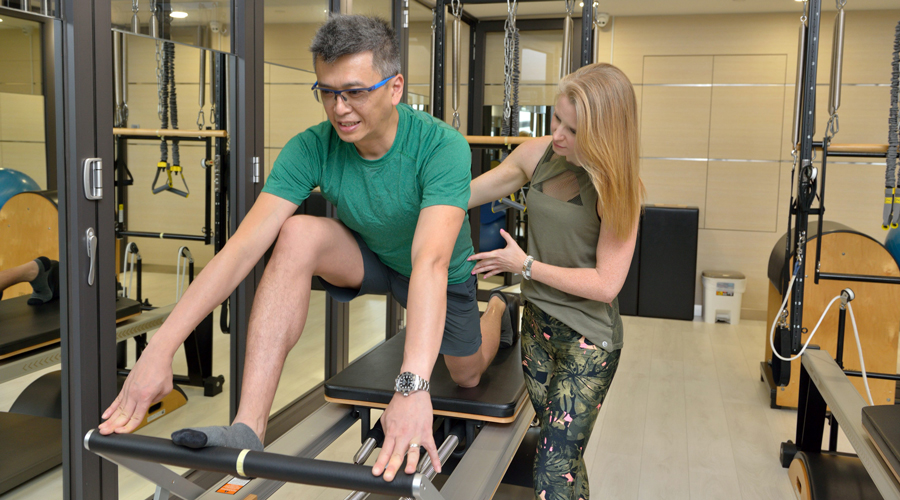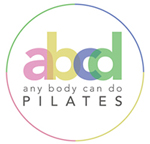0432 114 298
FAQ
1. What is Pilates?
Pilates (pronounced puh-lah-teez) is a physical fitness system developed in the early 20th Century by Joseph Pilates. He called his method Controlology, which refers to the way the exercises encourage the use of the mind to control the muscles. The name was later changed to Pilates. This form of mind-body exercise builds strength, improves flexibility and creates lean muscle tone with an emphasis on lengthening the body and aligning the spine. It focuses on awareness of breath, alignment of the spine, and strengthening of core muscles. The exercises performed correctly on a consistent basis promote ideal posture and ideal biomechanics by balancing the muscles of the body. Pilates is great fun and challenges the mind and the body.
2. What are the benefits of Pilates?
- Increases core strength, stability and peripheral mobility;
- Improved posture, you will sit and stand straighter and with more ease, some even feel a little taller;
- Helps prevent injury and great for pain relief and rehabilitation, particularly famous for relieving back pain;
- Enhances functional fitness and ease of movement;
- Balances strength and stability;
- Heightens body awareness;
- Improved general wellbeing, it will help you feel calmer and more powerful;
- Non-impact, so easy on the joints allowing more freedom of movement;
- Complements other methods of exercise;
- Develops muscular endurance, allowing you to do more and for longer;
- Develops a flat stomach and a toned body;
- Improves performance in sports;
- Better balance, coordination and circulation; and
- You will look better and feel better.
Think of Pilates as your insurance policy. With the regular practice of Pilates you will feel better and be able to do everything else in life better.
3. Pilates. It’s like Yoga right?
This is the most common question asked of Pilates instructors.
Conversations often go something like this…
Jeannie-Marie: Hi, I’m a Pilates instructor.
Person: Do you enjoy teaching Yoga?
Jeannie-Marie: You mean teaching Pilates. Yes, I love it.
Person: Oh yes, Pilates. But that’s the same as Yoga isn’t it?
Jeannie-Marie: No, it’s Pilates…. (*facepalm*)
Here’s a brief outline of the similarities and key differences between Yoga and Pilates.
Both are mind-body forms of exercise that focus on mobility and flexibility and use breathing to relax the body.
Yoga is based on the Yoga Sutras, (certain body postures and movement) and uses meditation and chanting to attain spiritual insight.
Pilates focuses on a method of breathing and movements that control and strengthen the core postural muscles. The exercises are dynamic and low impact and improve stability, flexibility, muscular endurance and tone and ideal biomechanical movements.
Yoga achieves a mind-body connection in a purposeful way, breathing and chanting of mantras and dedicated meditation time.
Pilates also achieves a mind-body connection, albeit, almost as a happy coincidence. By following the ideal breathing and movement patterns, Pilates exercises guide you to drop out of your head and into your body, helping you to focus and relax. When you are focused on the breathing pattern, how to hold your pelvis, the placement of your rib cage, maintaining a stable scapula, and the ideal head and neck alignment…AND moving your arms and legs in a controlled and coordinated fashion one doesn’t have the brain capacity to also think about the 427 things on their to-do list. Pilates makes you feel calm and happy because you can’t do Pilates and worry at the same time. Pilates allows you to be in the moment.
4. I am healthy and fit why do I need to do Pilates?
Pilates is powerful in its effectiveness at targeting your entire body in a single workout, all your muscle groups will be used. More and more famous athletes and professional sporting stars have Pilates as an integral part of their training program. Pilates emphasizes elongating the muscles and creating space between the joints, while simultaneously building stability. The increased range of motion you’ll experience from Pilates can help prevent injury and promote longevity in any sporting career. Sometimes called “prehab”, Pilates facilitates more efficient movement in all other sporting endeavors. With a stronger core, you can run faster, your yoga is on point, and overall the rest of your workouts improve. Fabulously fit bodies experience great results with Pilates. Come and have some fun and challenge yourself with the intermediate and advanced exercises.
5. How can I book a session?
You can book a session by contacting me here
6. Isn't Pilates is just stretching for women?
Hahaha. Pilates is for every body.

In fact, Pilates was developed by a man for men. When Joseph Pilates first opened his New York studio many of his clients were men who were boxers, wrestlers and other athletes of varying disciplines. Joseph Pilates studio was in a building with many dance schools so dancers were some of his first clients, this increased the popularity of Pilates for women. Men really benefit from Pilates, including professional athletes benefit from practicing Pilates. It’s a challenging workout that emphasizes the importance of core stability, strength, balance, and flexibility to prevent injury and improve athletic performance. Pilates is one of the most challenging and rewarding workouts given how it can transform your body.
Just like regularly servicing your car, you need to regularly service your body.
When practiced consistently the benefits of Pilates include a refreshing mind-body workout, development of your core muscles, improved posture, increased flexibility and decreased stress.
7. Once, twice, third times a charm…how often should I do Pilates?
Ideally everyone would be doing Pilates 2-3 times per week. Consistency is the key with Pilates. Like any exercise program the more you do it the faster you will see changes in your body and maximize your results. Private sessions are more efficient and you will develop faster with personalized attention. Be realistic with your schedule and your life commitments, if you can commit to a Pilates session once a week that’s great too.
8. I’m not very flexible. Can I still do Pilates?
Absolutely. This is a perfect reason to add Pilates to your life. You will improve your range of movement and become more flexible with Pilates. Improved hip and hamstring flexibility from Pilates is particularly beneficial.
Do you have tight hamstrings? Limited range of movement in your pelvis? Can’t touch your toes? Let me help you to improve all of this and more. I will guide you to feel better in your body.
9. I have health issues that limit my participation in regular exercise, do I need medical clearance for Pilates?
Pilates is a form of exercise that can be done by the young and old, the elite athlete or a complete beginner to exercise, men or women.
Some health conditions may require a clearance from your Doctor or other health practitioner. Pilates can be modified to suit individual needs and is a wonderful for injury rehabilitation. In the acute stages of an injury, certain periods following surgery and other circumstances we may need to delay your Pilates program until it is safe for you to exercise. If you have a specific injury or health condition that restricts your ability to move freely or any kind of chronic injury please give me a call to discuss the detail of your situation and how I can tailor a program for you.
10. What if I’ve never done Pilates?
You’ll be in capable and patient hands. Everyone needs to start somewhere and starting with private sessions is the best way to be introduced to Pilates. You’ll learn the fundamental principles that are the foundation of every Pilates exercise. Together we will find your core muscles and have them happy, responsive and strong very quickly. Come and get started, you’ll love it.
Call or email if you have any other questions and I’ll be happy to help.
any body can do PILATES - Put Your Body At The Top Of Your Priority List

